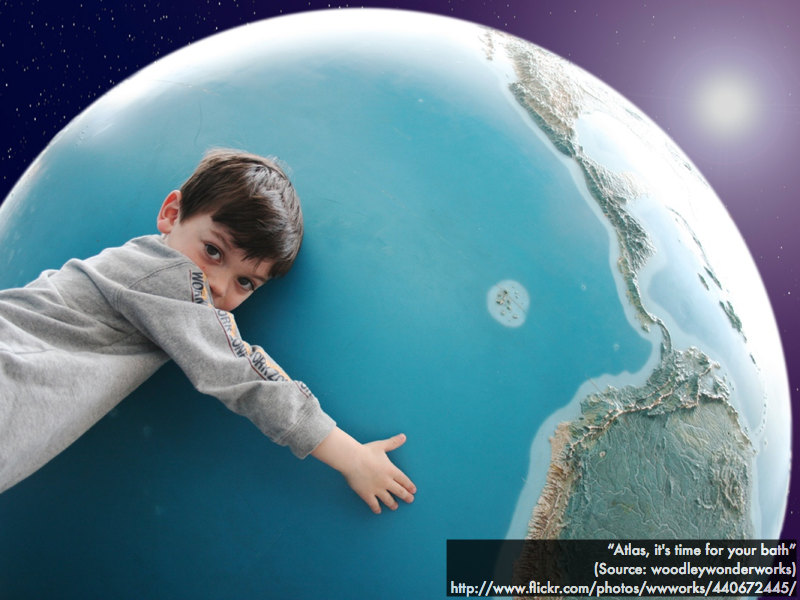Cuesta College, San Luis Obispo, CA
Students have a weekly online reading assignment (hosted by SurveyMonkey.com), where they answer questions based on reading their textbook, material covered in previous lectures, opinion questions, and/or asking (anonymous) questions or making (anonymous) comments. Full credit is given for completing the online reading assignment before next week's lecture, regardless if whether their answers are correct/incorrect. Selected results/questions/comments are addressed by the instructor at the start of the following lecture.
The following questions were asked on reading textbook chapters and previewing presentations on problems caused by the atmosphere for telescope observing, Earth, and the impacted worlds: the moon, and Mercury.

Selected/edited responses are given below.
Describe something you found interesting from the assigned textbook reading or presentation preview, and explain why this was personally interesting for you.
"I found it interesting that light from towns blocks us from seeing all the stars, I've noticed this when I go out camping but I never knew why I would see more stars out camping than in a city or anywhere with a lot of man-made light. Made me want to move."
"How the atmosphere can distort the views of space through our eyes and telescopes."
"That we have placed telescopes so high up (including mountain summits and space) in order to bypass atmospheric turbulence. It never occurred to me that seeing into space could be so obstructed by something like that."
"How volcanic activity emits carbon dioxide, and how our oceans not only help collect the water vapor from volcanic activity, but also absorbs carbon dioxide."
"I did not realize Mercury and the moon's appearance are so similar."
"I like the example of how carbon dioxide dissolved in the water because it is highly soluble in water--which explains the easy manufacture of carbonated beverages."
"I liked the turkey-cornish hen analogy. It made it easy to understand why bigger planets are hotter."
Describe something you found confusing from the assigned textbook reading or presentation preview, and explain why this was personally confusing for you.
"Active optics versus adaptive optics. It makes it less distorted but smaller? How exactly does adaptive optics remove 'twinkling' movements in images of stars?"
"I'm wondering where the funding comes from for all of these satellites and spacecraft. This is personally confusing for me because I am so broke."
"I don't really understand why we use radio telescopes. I'm not sure what the benefit is of knowing that information."
Stars to appear to "twinkle" in the night sky because of:
"Distortions caused by telescopes."
"Much like looking up at the sky underwater the sky looks distorted from the motion of the water, making it appear differently. it is in the same sense that when looking at the sky at night the air distorts the sky making the stars look like they are twinkling."
"Atmospheric turbulence."
A large modern optical telescope in outer space would have images with better __________ than a comparable ground-based telescope.
brightness. ** [2] resolution. **************** [16] magnification. *** [3] (None of the above choices.) * [1] (Two of the above choices.) ***** [5] (All of the above choices.) *********** [11] (Unsure/guessing/lost/help!) [0]
Identify how carbon dioxide enters and how it is taken out of Earth's atmosphere. (Only correct responses shown.)
Enters atmosphere from: volcanoes [61%]
Taken out of atmosphere by: oceans [53%]
Identify the oldest (longest ago) to the youngest (most recent) features on the moon. (Only correct responses shown.)
Craters partially filled in with flat lava plains: oldest (formed longest ago) [32%]
Flat lava plains: middle [55%]
Craters on top of flat lava plains: youngest (formed most recently) [45%]
Identify the oldest (longest ago) to the youngest (most recent) features on Mercury. (Only correct responses shown.)
Large crater basins: oldest (formed longest ago) [53%]
Lava-filled lowlands: middle [47%]
Long curving ridges: youngest (formed most recently) [68%]
Ask the instructor an anonymous question, or make a comment. Selected questions/comments may be discussed in class.
"How do you differentiate between a star and a planet?" (To the naked eye, stars twinkle, but planets do not twinkle (and are also found in slightly different positions in the sky night after night).)
"If stars don't really twinkle, then why is there still movement shown in the adaptive optics *.GIF? (Removing twinkling using adaptive optics is not completely perfect, but only needs to be as good as the resolving power of the telescope. Any more correction is not going to matter.)
"What are the oldest parts of the moon and Mercury?" (We'll go over this in class, along with more details on adaptive optics.)
"I like this class. I've been studying a lot more for the second quiz since I did so poorly on the first one. I feel pretty confident in my comprehension of the material, but I did the first time too, so..." (Good luck, and try your best!)
No comments:
Post a Comment